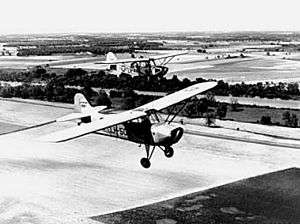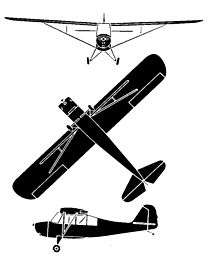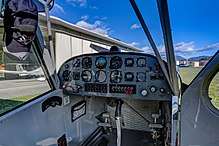Aeronca L-16
The Aeronca L-16 was a United States Army liaison aircraft built by Aeronca. It saw extensive service during the Korean War. It was essentially a militarized version of the Aeronca Champion. From 1955 large numbers were transferred to the Civil Air Patrol.[1]
| L-16 | |
|---|---|
 | |
| Role | liaison aircraft |
| Manufacturer | Aeronca |
| Primary users | United States Army National Guard of the United States Civil Air Patrol |
| Produced | 1946-1950 |
| Number built | 609 |
| Developed from | Aeronca Model 7 Champion |
.jpg)
A 1956-built Aeronca 7BCM in 2011 painted to represent an L-16A
Derived from the Aeronca Champion (Aeronca Model 7 series), the L-16 primarily replaced the similar Piper L-4 (a modified Piper Cub) in U.S. military service. The L-16 afforded generally better performance, stability, visibility and comfort, while its safety characteristics were a mix of better and worse than the L-4. [2] [3] [4]
Variants

- L-16A (7BCM Champion)
- 509 built, 376 of them produced for the Air National Guard,[5] used in Korea 1950, 85 hp (63 kW) Continental O-190-1 (C-85) engine.[6]
- L-16B (7CCM Champion)
- Military version of the Model 7AC used as training aircraft for United States Army,[6] 90 hp (67 kW) Continental O-205-1 engine.[7] 100 built.[1]
Operators
- National Guard of the United States
- United States Army
- Civil Air Patrol
- National Safety Forces
Specifications (L-16B)

L-16 7BCM 1947 Cockpit
Data from United States Military Aircraft Since 1909[5]
General characteristics
- Crew: Two
- Length: 21 ft 6 in (6.55 m)
- Wingspan: 35 ft 0 in (10.67 m)
- Height: 7 ft 0 in (2.13 m)
- Wing area: 170 sq ft (16 m2)
- Empty weight: 890 lb (404 kg)
- Gross weight: 1,450 lb (658 kg)
- Powerplant: 1 × Continental O-205 air-cooled flat-four, 90 hp (67 kW)
Performance
- Maximum speed: 110 mph (180 km/h, 96 kn)
- Cruise speed: 100 mph (160 km/h, 87 kn)
- Range: 350 mi (560 km, 300 nmi)
- Service ceiling: 14,500 ft (4,400 m)
- Rate of climb: 800 ft/min (4.1 m/s)
gollark: Ugh, Firefox wants me to "restart" it so it can "update".
gollark: I guess those are also WiFi devices now. But still.
gollark: Anyway, this is for WiFi devices, not phones.
gollark: And the signal strength is way easier to measure anyway.
gollark: The geographically nearest tower might not actually have the best signal.
References
| Wikimedia Commons has media related to Aeronca L-16. |
- Andrade 1979, p. 130
- Aerofiles.com, "Aeronca" page, Aircraft section, retrieved Feb. 22, 2016
- Davisson, Budd. "Comparing the Classics: The Aeronca Champ," EAA/Sport Aviation, June 1997, Experimental Aircraft Association, as reproduced on the author's website, retrieved 2016-02-01
- Air Training Department, The Artillery School, U.S. Army, "The New Grasshopper—L-16," (semi-official U.S. Army tutorial written to guide pilots transitioning from the Piper L-4 to the Aeronca L-16) The Field Artillery Journal, Nov-Dec 1947, United States Army,
- Swanborough and Bowers 1964, p. 33.
- Eden and Moeng, 2002. p. 44.
- Harding 1997, p. 13
- Andrade, John (1979). U.S.Military Aircraft Designations and Serials since 1909. Midland Counties Publications. ISBN 0-904597-22-9.
- Eden, Paul and Moeng, Soph, eds. The Complete Encyclopedia of World Aircraft. London: Amber Books Ltd., 2002. ISBN 0-7607-3432-1.
- Harding, Stephen (1997). U.S. Army Aircraft Since 1947. Atglen, PA, USA: Schiffer Publishing Ltd. ISBN 978-0-7643-0190-2.
- Swanborough, F. G.; Bowers, Peter M. (1964). United States Military Aircraft Since 1909. London: Putnam.
This article is issued from Wikipedia. The text is licensed under Creative Commons - Attribution - Sharealike. Additional terms may apply for the media files.